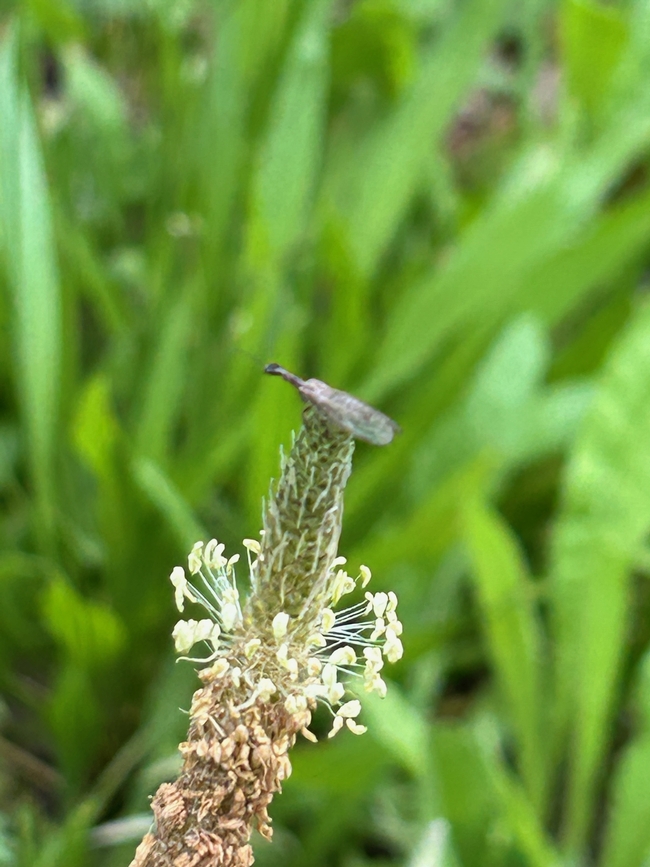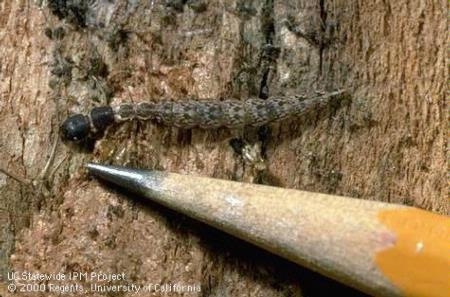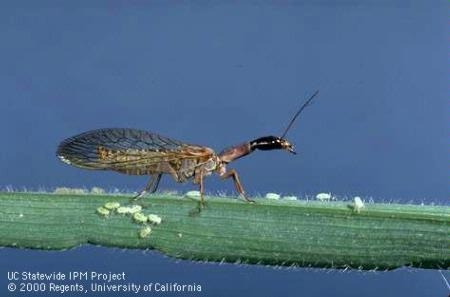Watch out ACP, Persea Mite, Avocado Thrips. Here comes Snake Fly. Not a snake. And not a fly. But a snakefly. It's always fun to be reminded that there are lots of different predators out there, and this one is one of the more voracious. Although because of its slow reproductive cycle, you don't see a lot of them until you start seeing them all over the place. Here's one that came up in a recent text message.
Photo: Jane Delahoyde
Snakeflies are related to lacewings (order Raphidioptera, rhaphidiids). The adult has a long thorax and can raise the head above the rest of the body which gives it the appearance of a snake ready to strike. Snakeflies are found world-wide, but only in western North America on this continent. Larvae live under the bark of forest, ornamental and fruit trees, including avocado and citrus. They can be helpful predators in fruit orchards. Adults also are predaceous. They would work in concert with other predators for control of Asian Citrus Psyllid and avocado mite and thrips.
Hosts
Larvae feed on wood-boring insects, small insects such as aphids and caterpillars, and various insect eggs, often feeding on insects and mites found in leaf duff. Snakefly adults feed on aphids or other small, weak prey.
Life stages
Egg -The egg is elongated and cylindrical with a small appendage at one end.
Larva - The larva is long and flattened with a black shiny head and prothorax and three pairs of legs. It can be from 1/2 to almost 1 inch (12 to 25 mm) long and is a mottled reddish or grayish color.
Pupa -The pupa is active and not enclosed in a cocoon.
Adult - Snakeflies have four membranous wings which are held roof-like over the body when at rest. The wings, which have many veins, are from 1/4 to 2/3 inch (6 to 17 mm) long. The prothorax is elongated. The female is usually slightly larger than the male and has a long tail-like ovipositor.
Life history
Most species have one generation each year but take 2 to 3 years to complete their life cycle. The larva overwinters in a small depression on the bark surface covered by small pieces of bark. After pupation under the bark, adults emerge and disperse in search of prey. They can be seen in orchards throughout the season.
Adult snakeflies are territorial and carnivorous organisms. They are diurnal and are important predators of aphids and mites. Pollen has also been found in the guts of these organisms and it is unclear whether they require pollen for part of their lifecycle or if it is a favoured food source. The larvae of many raphidiids live immediately below the bark of trees, although others live in crevices in rocks, among leaf litter and in detritus. Here they feed on the eggs and larvae of other arthropods such as mites, springtails, spiders, barklice, sternorrhynchids and auchenorrhynchids. The actual diets of the larvae vary according to their habitats, but both larvae and adults are efficient predators.
What predates/parasitizes snakeflies?
Birds eat them. They predate each other making it difficult to raise in an insectary. And they are parasitized by wasps.


